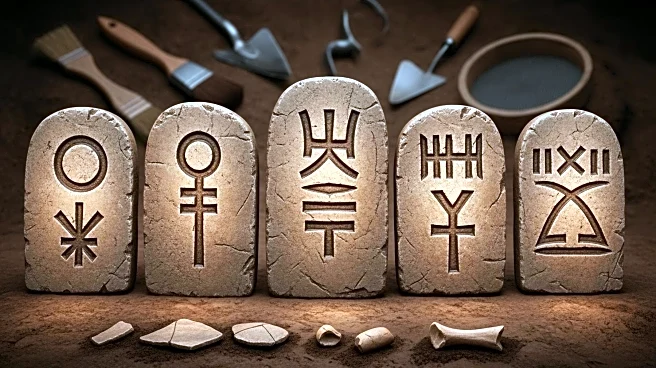What's Happening?
Researchers from the University of Copenhagen have made a significant discovery regarding ancient murals and pottery found in Teotihuacan, Mexico. Magnus Pharao Hansen and Christopher Helmke have identified a structured script within these artifacts,
suggesting a connection to early forms of the Uto-Aztecan language family, particularly an ancient version of Nahuatl. This challenges previous theories that the symbols were purely decorative or ritualistic. The findings indicate that the murals may contain a coherent writing system using visual logograms and phonetic signs, a method known as the rebus principle. This discovery could reshape the understanding of cultural continuity in central Mexico and provide insights into the daily life and identity of Teotihuacan's residents.
Why It's Important?
The identification of a structured language within Teotihuacan's murals has significant implications for the understanding of Mesoamerican history and linguistics. It challenges long-held assumptions about the timeline of Nahuatl-speaking peoples in central Mexico, suggesting they may have been present during the city's peak rather than after its decline. This could lead to a reevaluation of cultural links between Teotihuacan and later civilizations, potentially indicating that post-Teotihuacan groups inherited language and cultural practices directly from the city's original inhabitants. The discovery also opens new avenues for interpreting Mesoamerican scripts, offering a method to decode ancient texts using language reconstructions matched to the appropriate historical period.
What's Next?
Further research is needed to validate the hypothesis that the symbols form a coherent writing system. Researchers aim to find more examples of the same signs used consistently across different contexts to strengthen their argument. This ongoing work could lead to a deeper understanding of the linguistic and cultural history of Teotihuacan and its influence on subsequent Mesoamerican civilizations. The findings may also prompt scholars to reconsider the linguistic timeline and cultural interactions in the region, potentially leading to new interpretations of archaeological evidence.
Beyond the Headlines
The discovery of a structured language in Teotihuacan's murals not only has implications for linguistics but also for understanding the cultural identity of its inhabitants. The presence of a decipherable script could unify diverse elements within the city, tying art, rituals, and daily practices to specific peoples and traditions. This could enhance the understanding of how language and art contributed to the cultural identity of Teotihuacan's population and its influence across Mesoamerica. The research highlights the importance of interdisciplinary approaches in archaeology, combining linguistic analysis with historical and cultural studies to uncover new insights into ancient civilizations.
















